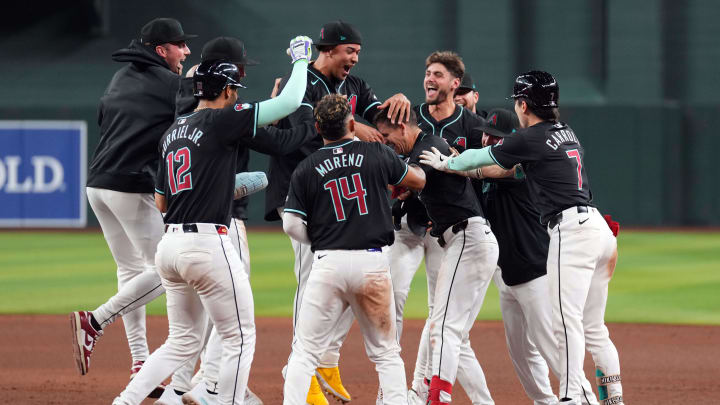Everything You Think About the Diamondbacks' Situational Hitting is Wrong

The Arizona Diamondbacks are coming off a heartbreaking loss to the Dodgers last night in which they were walked off in the bottom of the 9th inning to lose 6-5. Losses like that, especially in a season like the one the Diamondbacks are having (41-44 record), can be especially deflating.
They also lend themselves to overreaction to certain events within the game. Obviously the decision to pitch to Freddie Freeman received the most attention. But what about the 4th inning failure to score any more runs, after loading the bases with nobody out following Christian Walker's two-run homer?
While it may seem natural to point to that as one of the biggest reasons the D-backs didn't win, that viewpoint completely overlooks the great high leverage offense work the team put out in the 7th, 8th and 9th innings.
Furthermore, due to recency bias, many may feel like the 4th inning failure to tack on more runs or scoring by the offense in key situations is the crux of the D-backs' problems this year.
The full 85-game sample reveals just the opposite however. The D-backs have been one of the better offensive teams in the league, and one of the worst pitching teams.
Arizona ranks 9th best in MLB in runs scored per game, with 4.69. The team pitching ERA ranks 29th in MLB at 4.67, better than only Colorado. Runs Allowed per game is 4.86, which is the 5th worst in MLB.
But what about situational stats? How does the team do with runners in scoring position, or bases loaded, or high leverage, compared to other teams? How often does the pitching pick up the offense compared to how often the offense lets the pitching down? Prepare to have some of your preconceived notions flipped on their heads.
Batting Avg W/RISP, League Avg .255
The Diamondbacks offense ranks 4th best in MLB, posting a .276 BA W/RISP
The Diamondbacks pitching ranks 4th worst in MLB, allowing a .273 BA W/RISP
Bases Loaded, League Avg BA .256, OPS .741
The Diamondbacks offense ranks 2nd best in MLB in BA and OPS, .349 and .932 respectively.
The Diamondbacks pitching ranks 5th worst in MLB in BA and 6th worst in OPS against, .329 & .968.
High Leverage League Avg OPS .718
The Diamondbacks offense ranks 12th best in MLB with a .741 OPS.
The Diamondbacks pitching ranks the worst in MLB with a .812 OPS against.
Note: To learn more about leverage stats see this link.
Scoring or Allowing 3 Runs or Less
Earlier in the year the D-backs had a number of high scoring games that skewed their season averages, leading to the "feast or famine" narrative. But as the season has gone on, that narrative has faded. Let's take a look at this a little differently.
The D-backs have scored 3 runs or fewer in 36 games. That raw total ranks as the 11th lowest (best) in MLB, slightly better than the league average 38.
But the D-backs W% in those games is just .139, compared to league average .203. That's the 4th worst W% when scoring 3 runs or less in MLB.
So what does that tell you? On the days when the offense is having a bad day, the pitching almost never bails them out. They almost always lose, and lose much worse than the league average.
The D-backs are 29-6 when allowing three or fewer runs, for an .829 Win percentage. That's the 10th best in MLB. This means the D-backs offense has been the 10th best in baseball in making a good pitching performance stand up.
There are more such measures, but I think these are sufficient to make the point. Certainly it's been an extremely tough season for injuries, especially in the starting rotation. Merrill Kelly has made just four starts and Eduardo Rodriguez has made none. Zac Gallen missed a month with a hamstring injury.
Jordan Montgomery, the other big pitching acquisition, has been a bust, as he's posted a 6.44 ERA in 13 starts. He's now on the 15-Day IL with knee inflammation. Not one of their young starters has stepped into the breach to post a sub 4.00 ERA. Brandon Pfaadt has come the closest, with a 4.28 ERA. Ryne Nelson, (5.42) Slade Cecconi (5.81) and Tommy Henry (7.04) bring up the rear.
The bullpen improved with the return of Paul Sewald to be sure. He's been great. 11-for-11 in save chances before last night. Overall, Sewald, Ryan Thompson and Justin Martinez have put up microscopic ERAs. But some regression to the mean was expected there and it's been happening lately. D-backs Reliever Splits since June 15th.
The bottom line is no matter how you slice it, the offense has been an above average offense in key situations and in total. Meanwhile the pitching is near the worst in the league and must improve if the Diamondbacks are to have any chance to get back to the postseason.
